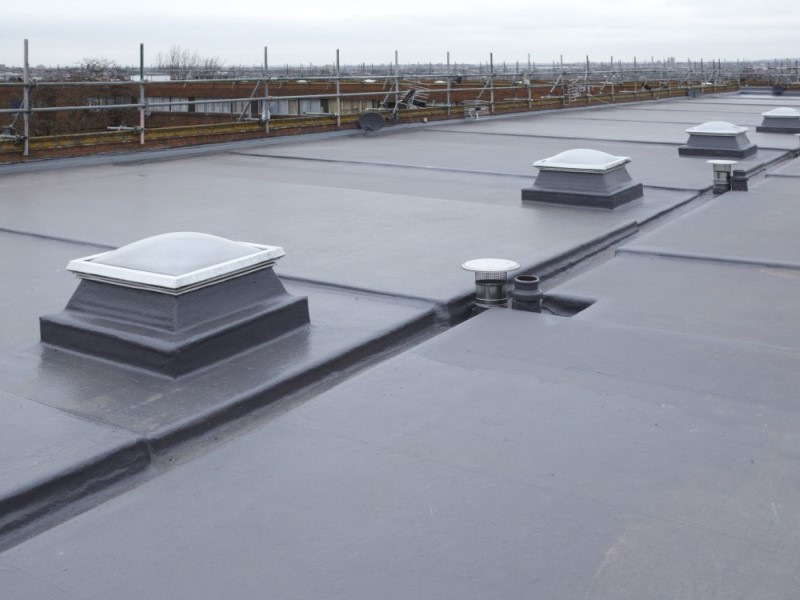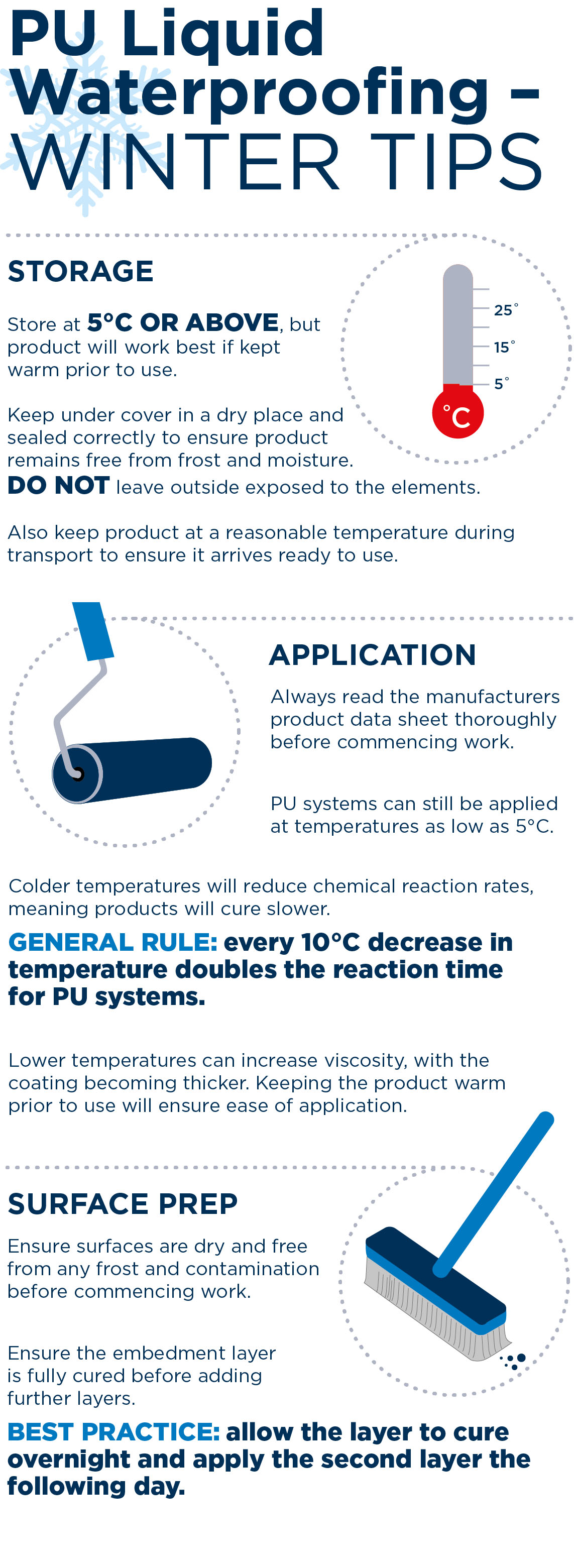Best Practice Advice for Applying Polyurethane Liquid Waterproofing Systems in Winter
Published: 17 January 2022
Updated: 08 December 2022
The increased risk of colder temperatures and harsher weather expected throughout winter can affect the application of liquid waterproofing systems. There are best practices to follow to get the most out of systems during winter months.

As featured in Roofing Today Magazine (page 28), Here Darrell Tibbins, Director of Technical at Apollo Roofing explains the benefits of polyurethane (PU) systems and offers his advice.
What are PU liquid waterproofing systems?
PU technology has a long established history in the construction sector due to its versatility and tolerance to extreme temperatures and chemicals. Its excellent weathering properties have made it a great choice for adhesives used in products from airplanes to structural panels, as well as for liquid waterproofing systems.
PU liquid waterproofing systems are generally cold-applied single-component roofing systems that cure to form a completely seamless and joint-free waterproof coating. The system is moisture-triggered, reacting with moisture in the air to cure once applied. They are largely multi-layer systems, consisting of a base-coat, an embedded glass fibre mat layer to reinforce the coating, and one or more top-coat layers. PU is already a very tough material on its own, but the reinforcement layer ensures the coating provides a hard-wearing and long-lasting waterproofing solution.
Benefits of PU liquid waterproofing systems
PU systems are durable waterproofing systems able to withstand significant stress due to their elastomeric properties. This provides high levels of flexibility, reducing the occurrence of potential cracks due to the coating mitigating any movement in the existing structure. Systems can have a lifespan of 25+ years (dependant number of coats). Once cured, it forms a tough coating that is weatherproof and tolerant to extreme temperatures (-30°C to 80°C), water and chemicals.
Single-part PU systems can help to reduce project time, especially helpful in winter months when available working windows are smaller. They do not require mixing and are simple to apply with a roller or brush. This not only allows for faster application; it eradicates the risk of error caused by incorrect mixing ratios. Systems will cure in 6-12 hours and can be laid at 5°C. This helps to minimise the number of postponed jobs.
Suitable for overlay, the systems are ideal for refurbishment projects helping to extend the life of the roof, without the cost of replacement. Systems are usually compatible with a wide range of roof substrates, including mastic asphalt, RBM, PVC, single-ply, metals, wood, concrete, PU liquid applied coatings and insulation boards (PIR & Rockwool) with carrier membrane. They are also a great choice for new build projects where use of naked flames is restricted.
WINTER ADVICE
Storage During Winter Months
Being moisture-triggered, it is essential to store PU products appropriately during colder and wetter weather. Time should be taken to properly store products when not in use, especially overnight. Products should be kept under cover in a dry place and sealed correctly to ensure they remain free from frost and moisture. Do not leave the products outside exposed to the elements. If products are stored on the roof, they should be stored on insulation rather than on the cold roof deck.
Products must be stored at 5°C or above, but will work best if kept warm prior to use. Keeping product at a reasonable temperature during transport is equally as important to ensure the product arrives ready to be used.
Application Advice During Winter Months
Working with all liquid coating products can be more difficult in winter, regardless of technology. The products will behave differently than in warmer weather, but still can be an excellent waterproofing solution if care is taken when installing. Always read the manufacturers product data sheet thoroughly before commencing work.
PU systems can still be applied at temperatures as low as 5°C. However, please be aware that cure-times will be slower as colder temperatures reduce the chemical reaction rate. Most manufactures quote information on data sheets at 20°C. As a general rule, every 10°C decrease in temperature doubles the reaction time for PU systems.
At lower temperatures, a product’s viscosity can increase, with the coating becoming thicker. Keeping the product warm prior to use will ensure ease of application even on colder days.
Substrate Preparation During Winter Months
There are higher chances of moisture, such as rain or frost, appearing on the ground in winter months. Substrates need to be prepared appropriately, ensuring they are dry and free from any contamination before work can be commenced. Ensure the embedment layer is fully cured before adding further layers. It is best practice to allow the layer to cure overnight and to apply the second layer the following day.
PU systems offer an effective solution for your waterproofing projects. Using the systems properly and following our winter advice will ensure you result in a durable finished waterproof coating all year round.
The below infographic summarises our winter advice:

You may also be interested in
Sign up to our newsletter to get our blogs delivered straight to your inbox
This form is protected by reCAPTCHA and the Google Privacy Policy and Terms of Service apply.








